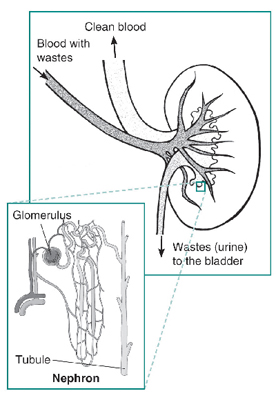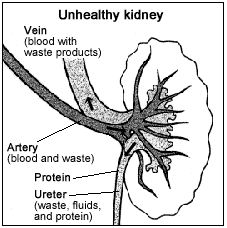Tracy Morgan Receives New Kidney
 Comedian Tracy Morgan, 42, is recovering from a kidney transplant. The 30 Rock star underwent the procedure on December 10th. Morgan, who has diabetes, is reportedly recovering well from the procedure, although he had to miss filming two upcoming episodes of the NBC comedy series. Co-star Grizz Chapman also received a kidney transplant this past August, although his kidney failure was due to high blood pressure.
Comedian Tracy Morgan, 42, is recovering from a kidney transplant. The 30 Rock star underwent the procedure on December 10th. Morgan, who has diabetes, is reportedly recovering well from the procedure, although he had to miss filming two upcoming episodes of the NBC comedy series. Co-star Grizz Chapman also received a kidney transplant this past August, although his kidney failure was due to high blood pressure.
Each year in the United States, more than 100,000 people are diagnosed with kidney failure, a serious condition in which the kidneys fail to rid the body of wastes. Kidney failure is the final stage of chronic kidney disease (CKD).
Diabetes is the most common cause of kidney failure, accounting for nearly 44 percent of new cases. Even when diabetes is controlled, the disease can lead to CKD and kidney failure. Most people with diabetes do not develop CKD that is severe enough to progress to kidney failure. Nearly 24 million people in the United States have diabetes, and nearly 180,000 people are living with kidney failure as a result of diabetes.
What are the kidneys and what do they do?
The two kidneys are bean-shaped organs located near the middle of the back, just below the rib cage to the left and right of the spine. Each about the size of a fist, these organs act as sophisticated filters for the body. They process about 200 quarts of blood a day to sift out about 2 quarts of waste products and extra water that eventually leave the body as urine.
 Blood enters the kidneys through arteries that branch inside the kidneys into tiny clusters of looping blood vessels. Each cluster is called a glomerulus, which comes from the Greek word meaning filter. The plural form of the word is glomeruli. There are approximately 1 million glomeruli, or filters, in each kidney. The glomerulus is attached to the opening of a small fluid-collecting tube called a tubule. Blood is filtered in the glomerulus, and extra water and wastes pass into the tubule and become urine. Eventually, the urine drains from the kidneys into the bladder through larger tubes called ureters.
Blood enters the kidneys through arteries that branch inside the kidneys into tiny clusters of looping blood vessels. Each cluster is called a glomerulus, which comes from the Greek word meaning filter. The plural form of the word is glomeruli. There are approximately 1 million glomeruli, or filters, in each kidney. The glomerulus is attached to the opening of a small fluid-collecting tube called a tubule. Blood is filtered in the glomerulus, and extra water and wastes pass into the tubule and become urine. Eventually, the urine drains from the kidneys into the bladder through larger tubes called ureters.
In the nephron (left), tiny blood vessels intertwine with fluid-collecting tubes. Each kidney contains about 1 million nephrons.
Each glomerulus-and-tubule unit is called a nephron. Each kidney is composed of about 1 million nephrons. In healthy nephrons, the glomerular membrane that separates the blood vessel from the tubule allows waste products and extra water to pass into the tubule while keeping blood cells and protein in the bloodstream.
What is Diabetic Nephropathy?
Diabetic nephopathy is the kidney disease caused by diabetes. The exact cause of diabetic nephropathy is unknown, but it is believed that uncontrolled high blood sugar leads to the development of kidney damage, especially when high blood pressure is also present.
Diabetic kidney disease takes many years to develop.  People who are developing kidney disease will have small amounts of the blood protein albumin begin to leak into their urine. This first stage of chronic kidney disease is called microalbuminuria. The kidney’s filtration function usually remains normal during this period.
People who are developing kidney disease will have small amounts of the blood protein albumin begin to leak into their urine. This first stage of chronic kidney disease is called microalbuminuria. The kidney’s filtration function usually remains normal during this period.
As the disease progresses, more albumin leaks into the urine. This stage may be called macroalbuminuria or proteinuria. As the amount of albumin in the urine increases, the kidneys’ filtering function usually begins to drop. The body retains various wastes as filtration falls. As kidney damage develops, blood pressure often rises as well.
Overall, kidney damage rarely occurs in the first 10 years of diabetes, and usually 15 to 25 years will pass before kidney failure occurs. For people who live with diabetes for more than 25 years without any signs of kidney failure, the risk of ever developing it decreases.
Symptoms
Early stage diabetic nephropathy has no symptoms. Over time, the kidney’s ability to function starts to decline. Symptoms develop late in the disease and may include:
- Fatigue
- Foamy appearance or excessive frothing of the urine
- Frequent hiccups
- General ill feeling
- Generalized itching
- Headache
- Nausea and vomiting
- Poor appetite
- Swelling of the legs
- Swelling, usually around the eyes in the mornings; general body swelling may occur with late-stage disease
- Unintentional weight gain (from fluid buildup)
The goals of treatment are to keep the kidney disease from getting worse and prevent complications. This involves keeping blood pressure under control (under 130/80). Controlling high blood pressure is the most effective way of slowing kidney damage from diabetic nephropathy. It is also very important to control lipid levels, maintain a healthy weight, and engage in regular physical activity. Close monitor of blood sugar levels is crucial. Doing so may help slow down kidney damage, especially in the very early stages of the disease.
For more information about diabetic kidney disease, click here to go to the Resounding Health Casebook on the topic.
![]()

